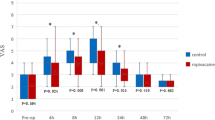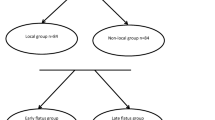Abstract
Background
This prospective double-blind study compared the analgesic properties of locally infiltrated levobupivacaine with those of ropivacaine in fleur-de-lys abdominoplasty.
Methods
A total of 46 patients subjected to fleur-de-lis abdominoplasty under general anesthesia were included. The patients were randomly assigned to receive local infiltration of the peri-incisional and dissected area with the following solutions: group A (placebo group, n = 15) received 100 ml of saline 0.9%, group B (n = 15) received 50 ml of ropivacaine 0.75% in 50 ml of saline 0.9%, and group C (n = 16) received 60 ml of levobupivacaine 0.25% in 40 ml of saline 0.9%. The anesthetic technique was standardized for all the groups. The patients were asked to assess their pain at rest on a visual analog scale (VAS) at 2 h, 4 h, and 24 h postoperatively. Data were analyzed by mixed analysis of variance (ANOVA), simple ANOVA, and repeated measures ANOVA, followed by Tukey’s test.
Results
Groups B and C did not differ significantly in their VAS scores at 2 h postoperatively, but group C experienced significantly less pain (p < 0.001) than either the control group or the B group at 4 h and 24 h postoperatively. Group B also registered significantly lower VAS scores (p < 0.001) than the placebo group at 4 h postoperatively.
Conclusions
It is concluded that for mini abdominoplasty, adequate analgesia is achieved for at least 4 h postoperatively by local tissue infiltration with either ropivacaine or levobupivacaine. However, in terms of intensity and duration of analgesia, levobupivacaine was found to be more effective than ropivacaine in reducing postoperative pain associated with mini abdominoplasty.

Similar content being viewed by others
References
Bardsley H, Gristwood R, Baker H: A comparison of the cardiovascular effects of levobupivacaine and rac-bupivacaine following intravenous administration to healthy volunteers. Br J Clin Pharmacol 46:245–249, 1998
Benhamou D, Ghosh C, Mercier FJ: A randomized sequential allocation study to determine the minimum effective analgesic concentration of levobupivacaine and ropivacaine in patients receiving epidural analgesia for labor. Anesthesiology 99:1383–1386, 2003
Casati A, Borghi B, Fanelli G: A double-blinded, randomized comparison of either 0.5% levobupivacaine or 0.5% ropivacaine for sciatic nerve block. Anesth Analg 94:987–990, 2002
Casati A, Chelly JE, Cerchierini E: Clinical properties of levobupivacaine or racemic bupivacaine for sciatic nerve block. J Clin Anesth 14:111–114, 2002
Cox CR, Checketts MR, MacKenzie N: Comparison of S(-)bupivacaine with racemic (RS)-bupivacaine in supraclavicular brachial plexus block. Br J Anaesth 80:594–598, 1998
Denson DD, Behbehani MM, Gregg RV: Enantiomer-specific effects of an intravenously administered arrhythmogenic dose of bupivacaine on neurons of the nucleus tractus solitarius and the cardiovascular system in the anesthetized rat. Reg Anesth 17:311–316, 1992
Fayman M, Beeton A, Potgieter E: Comparative analysis of bupivacaine and ropivacaine in infiltration analgesia for bilateral breast surgery. Aesth Plast Surg 27:100–103, 2003
Forster RH, Markham A: Levobupivacaine: A review of its pharmacology and use as a local anaesthetic. Drugs 59:551–579, 2000
Gristwood RW: Cardiac and CNS toxicity of levobupivacaine: Strengths of evidence for advantage over bupivacaine. Drug Saf 25:153–163, 2002
Huang YF, Pryor ME, Mather LE: Cardiovascular and central nervous system effects of intravenous levobupivacaine and bupivacaine in sheep. Anesth Analg 86:797–804, 1998
Kakagia D, Fotiadis S, Tripsiannis G: Comparative efficacy of ropivacaine and bupivacaine infiltrative analgesia in otoplasty. Ann Plast Surg 54:409–411, 2005
Kakagia D, Fotiadis S, Tripsiannis G: Levobupivacaine versus ropivacaine infiltration analgesia for mastopexy: A comparative study of 2 long-acting anesthetic drugs in infiltrative anesthesia for mastopexy. Ann Plast Surg 55:258–261, 2005
Kingsnorth AN, Cummings CG, Bennett DH: Local anaesthesia in elective inguinal hernia repair: A randomised, double-blind study comparing the efficacy of levobupivacaine with racemic bupivacaine. Eur J Surg 168:391–396, 2002
Klein JA: Anaesthesia for liposuction in dermatologic surgery. J Dermatol Surg Oncol 14:1124–1132, 1988
Knudsen K, Beckman Suurkula M, Blomberg S: Central nervous and cardiovascular effects of IV infusions of ropivacaine, bupivacaine, and placebo in volunteers. Br J Anaesth 78:507–514, 1997
Kopacz DJ, Allen HW, Thompson GE: A comparison of epidural levobupivacaine 0.75% with racemic bupivacaine for lower abdominal surgery. Anesth Analg 90:642–648, 2000
Launo C, Gastaldo P, Piccardo F: Perioperative thoracic epidural analgesia in aortic surgery: Role of levobupivacaine. Minerva Anestesiol 69:751–764, 2003
Lee A, Fagan D, Lamont M: Disposition kinetics of ropivacaine in humans. Anesth Analg 69:736–738, 1989
Lee YY, Muchhal K, Chan CK: Levobupivacaine versus racemic bupivacaine in spinal anaesthesia for urological surgery. Anaesth Intensive Care 31:637–641, 2003
Liisanantti O, Luukkonen J, Rosenberg PH: High-dose bupivacaine, levobupivacaine, and ropivacaine in axillary brachial plexus block. Acta Anaesthesiol Scand 48:601–606, 2004
Louizos AA, Hadzilia SJ, Leandros E: Postoperative pain relief after laparoscopic cholecystectomy: A placebo-controlled double-blind randomized trial of preincisional infiltration and intraperitoneal instillation of levobupivacaine 0.25%. Surg Endosc 19:1503–1506, 2005
Lyons G, Columb M, Wilson RC: Epidural pain relief in labour: Potencies of levobupivacaine and racemic bupivacaine. Br J Anaesth 81:899–901, 1998
Mazoit J, Boico O, Samii K: Myocardial uptake of bupivacaine. II: Pharmacokinetics and pharmacodynamics of bupivacaine enantiomers in the isolated perfused rabbit heart. Anesth Analg 77:907–982, 1993
McClure JH: Ropivacaine. Br J Anaesth 76:300–307, 1996
Mottura AA: The tumescent technique for facelifts? Plast Reconstr Surg 96:231–232, 1995
O’Donoghue JM, Chaubal ND, Haywood RM: An infiltration technique for reduction mammaplasty: Results in 192 consecutive breasts. Acta Chir Plast 41:103–106, 1999
Peduto VA, Baroncini S, Montanini S: A prospective, randomized, double-blind comparison of epidural levobupivacaine 0.5% with epidural ropivacaine 0.75% for lower limb procedures. Eur J Anaesthesiol 20:979–983, 2003
Petterson N, Berggren P, Larsson M: Pain relief by wound infiltration with bupivacaine or high-dose ropivacaine after inguinal hernia repair. Reg Anesth Pain Med 24:569–575, 1999
Scott DB, Lee A, Fagan D, Bowler G: Acute toxicity of ropivacaine compared with that of bupivacaine. Anesth Analg 69:563–569, 1989
Striker AK: Breast reduction under local anaesthesia with intravenous sedation. Plast Reconstr Surg 99:256–257, 1997
Tabari K: Augmentation mammaplasty under local anaesthesia. Plast Reconstr Surg 43:320–322, 1969
Urbanek B, Duma A, Kimberger O: Onset time, quality of blockade, and duration of three-in-one blocks with levobupivacaine and bupivacaine. Anesth Analg 97:888–892, 2003
Whiteside JB, Woldsmith JAW: Developments in local anaesthetic drugs. Br J Anaesth 87:27–35, 2001
Author information
Authors and Affiliations
Corresponding author
Rights and permissions
About this article
Cite this article
Kakagia, D.D., Fotiadis, S., Tripsiannis, G. et al. Postoperative Analgesic Effect of Locally Infiltrated Levobupivacaine in Fleur-de-Lys Abdominoplasty. Aesth Plast Surg 31, 128–132 (2007). https://doi.org/10.1007/s00266-006-0187-4
Published:
Issue Date:
DOI: https://doi.org/10.1007/s00266-006-0187-4




